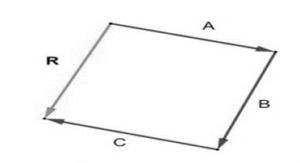Vectors are values that have both a magnitude and a direction. When they’re in the same or opposite directions, we can directly add and subtract.
To get the resultant point of two vectors or more, apply the resultant vector equation. This is accomplished by calculating the vectors depending on the relative directions.
Based on the orientation of the vectors, the resultant vector equation can be divided into three types. These formulas apply to vectors pointing in almost the same direction, vectors pointing in a reverse way, and vectors pointing in almost the same direction but at an angle to each other. 
Formula 1
To get the resultant vector, simply combine vectors in almost the same direction. P and Q are the same-direction vectors, while A is the resulting vector.
P + Q = A
Formula 2
To generate the resultant vector, vectors in opposite directions are deducted from each other. The consequent vector A is vector Q, which is in the opposite direction of vector P.
P – Q = A
Formula 3
To generate the resultant vector, compute vectors angled to each other using the formula below. A is indeed the resultant vector, and P and Q are slanted at an angle to each other here.
A2 = P2 + Q2 + 2PQCosØ
Solved example:
Question: A 30o angle is formed by two pressures of strength 5k and 10k. Using the parallelogram law, determine the strength and the direction of the resultant vector.
Solution:
Given the existence of two opposing forces, A 1 = 5k and A 2 = 10k, at a 30o angle.
|R|= √(A12+2A1A2cosθ+A22)
|R|= √ ((5)2+2(5)(10) cos30+(10)2)
|R| =14.54k
φ = tan –1(A2sinθ/A1+A2cosθ)
φ = tan-1 (10sin30/(5+10cos30))
φ = 20.1o
As a result, the resultant vector named R has a magnitude of 14.54k and a direction of 20.1o.
 Profile
Profile Settings
Settings Refer your friends
Refer your friends Sign out
Sign out



